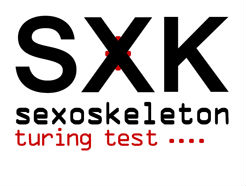
[Conceptual Description]
With a particular tribute to the work and life of Alan Turing as a starting point, this project approaches the concepts of artificial life and artificial intelligence, to the mechanisms of construction of subjectivity.
In an ironic way and willing to deconstruct, this installation proposes a sort of inversion of the Turing Test (two strangers separated by a wall are invited to relate bodily, using an sensorial exoskeleton and through a machine’s activity).
This situation poses a few questions: If it’s possible to have a corporal relationship in the distance, what is then the body? If this relationship can exist mediated by a machine, what is to be human? And, what is the distinction between natural and artificial? If no identity parameters can be applied (genre, race, social background, etc.) to the other, is it still relevant for the individual to apply these parameters? If this relationship is relevant without these codes, is it possible to invent new ones?
Comparing the human codes -operating under the western frame of mind-, to those of the machines, we observe that even though both share the binarism, they use it in a totally opposite way. Machines work with a code based on two sole digits (0 and 1) but they can be combined indefinitely. This enables the process and creation of any possible reality; being only limited by the amount of bits that its physicality supports. The human instead, functions with a code based on an endless number of digits: natural/artificial, human/machine, man/woman, homo/hetero, black/white, arts/science, reality/fiction… but they are exclusive and opposed, they can not be combined, so the process will always be limited to the juxtaposition of data of one bit (0 or 1) which interprets and generates a very reduced reality.
In order to exit this range of dualisms, where identity is based on otherness definition, we have taken from Donna Haraway her metaphor of the cyborg as possibility of hybrid identities, ‘imploded germinal entities, densely packed condensations of worlds, shocked into being from the force of the implosion of the natural and the artificial, nature and culture, subject and object, machine and organic body, money and lives, narrative and reality.’
In this test, physical relationship takes place through an external prosthesis structure, the sexoskeleton, which acts as an interface between two people. Here, the image of the cyborg is not that of an improved body, but a modified one. A cyborg, that instead of getting rid of an obsolet body, represents a corporality which limits are not set in the flesh. A body, that appears as a subjective interface. A body as a bio-technological creation of flesh, prosthesis and code; merged and in constant retro alimentation. The code is part of the body, as software is to the computer. What appears obsolete here is not the body, but the codes that compose it.
We are not before telepathy, we are looking at telesoma.